Genus: Psittacosaurus OSBORN, 1923
Etymology: Greek, psittakos, “parrot” and Greek, sauros, “lizard”: “Parrot-beaked
lizard”.
= Hongshanosaurus YOU, XU & WANG, 2003
Etymology: Chinese, Hon Shan, "red hill" for the "Red
Hill Culture” which existed about 6,000 years ago in western Liaoning,
northeastern China, where this specimen was found, and Greek, sauros, "lizard."
= Psitaccosaurus KEUPP & KOHRING,
1993 (sic)
= Prittacosaurus RHOZHDESTVENSKY, 1974 (sic)
= Proiguanodon DONG, 1979 (sic)
= Protiguanodon OSBORN, 1923
Etymology: Greek, protos, “first” + Iguandon.
= Psittacocaurus CHENG, HU & FANG, 1995 (sic)
= Psittacorus CZERKAS & OLSON, 1987 (sic)
= Pssitacosaurus SANTA LUCA, 1980 (sic)
Species: mongoliensis OSBORN, 1923
Etymology: In reference to Mongolia, where the specimen was found.
Holotype: AMNH 6254
Locality: Red Mesa, Artsa Bogdo basin, Öösh (Ööshinn Nuur, Ashile, Osh, Oshih Basin), Northern Gobi, Mongolia.
Horizon: Ohshih Formation (Ashile Formation).
Biostratigraphy:
Age: Aptian-Albian Stage, Middle Gallic Subepoch, Upper Early Cretaceous Epoch, Early Cretaceous.
Material: Skull and skeleton.
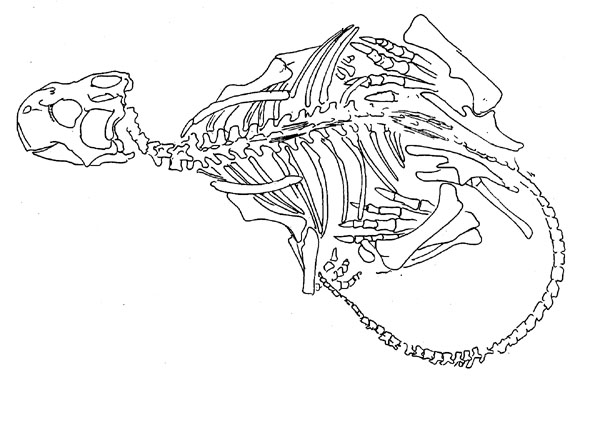
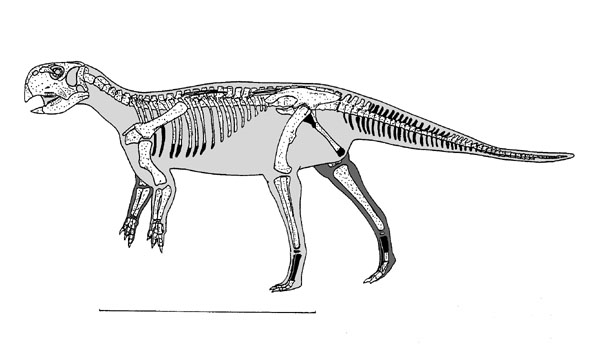
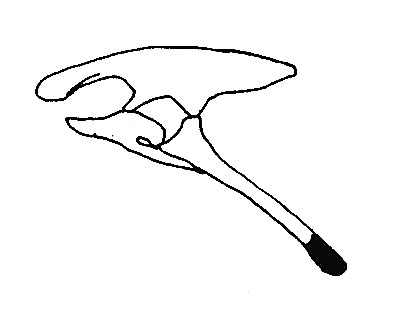
Referred material:
AMNH 6261: Fragmentary skull.
ERICKSON & TUMANOVA, 2000
PIN 1369/1-11/1948, PIN 698/1977, PIN 698/15/1977, PIN 1369/1-11/1948, PIN 698/5-3/1946: Humeri.
PIN 687/4-22/1946, PIN 698 /7-4/1946, PIN 698/1977, PIN 698/15/1977, PIN 698/2-2/1977-15: Femora.
PIN 698/4-22/1946, PIN 698/2-2/1977-15, PIN 698/5-9/2/1946: Tibiae.
COOMBS, 1980, 1982
AMNH 6535: Fragmentary skull and jaws, articulated skeleton, atla,s dorsal vertebrae, ribs both sternals, both scapulae, and both coracoids of a baby.
AMNH 6536: Almost complete skull and jaws with numerous disarcticulated postcranial elements including cervical, dorsal and caudal vertebrae, ribs, scapulae, coracoid, partial ilium and ischium, humeri, femora, tibiae, fibulae and an almost complete pes of a baby. The postcranial material belongs to several individuals (there are fourteen distal ends of tibiae) of at least two different sizes. Rather than allot separate numbers to every element, all of the postcranial material is arbitrarily assigned to AMNH 6536.
Note: Furcula.
Psittacosaurus mongoliensis (after CARPENTER & ALF, 1994), AMNH 6536.
Psittacosaurus mongoliensis (after CARPENTER & ALF, 1994), AMNH 6536.
Nests.
SERENO, 1987
AMNH 6255: Articulated caudal vertebral column, left ilium, left tibia and left fibula of a juvenile.
AMNH 6256: Right and left calcanea and partial left pes.
AMNH 6257: Fragmentary vertebrae, distal left humerus, and left carpus and manus lacking only the ulnare and terminal phalanx of digit IV.
AMNH 6260: Fragmentary skeleton including a cranium, lacking the dorsal skull roof in a block, and postcranial including articulated cervicals 1-7, sacrum with ossified tendons, caudals, fragmentary humeri, radii, ulnae, carpus, manus, femora, tibiae, fibulae, astragalia, left distal tarsals, left metatarsals and proximal phalanges and skin impressions.
AMNH 6261: Fragmentary, weathered skull with lower jaws and anterior cervicals in a block.
AMNH 6262: Cranial and postcranial fragments of several individuals including the predentary, left anterior dentary, right coracoid, right proximal femur, and left pubis.
AMNH 6263: Large left distal femur and left proximal tibia and fibula.
AMNH 6534: Skull with lower jaws and hyoids, atlas and 3 anterior caudal vertebrae, fragmentary ribs, right scapulocoracoid, fragmentary right ilium, right femur, and phalanges of right digit I.
AMNH 6537: Partial skeleton including the left scapula.
AMNH 6538: Fragmentary skeleton including the left proximal scapula, left coracoid, distal left humerus, right and left femora, right and left tibia, right fibula, left astragalus and distal tarsal and left metatarsals 1-4.
AMNH 6539: Left surangular, dorsal vertebra, left proximal scapula, left coracoid, right ulna, left proximal ulna and radius, right and left proximal femora, and left proximal metatarsals 1-4.
AMNH 6540: Relatively complete, crushed skull with lower jaws and fragmentary postcranial skeleton including vertebrae, ribs, sternal fragment, fragmentary left scapula and coracoid, left humerus, left radius and ulna, left ilium, left femur and tibia, left metatarsal 4 and the proximal phalanx of left digit I of a juvenile.
AMNH 6541: Postcrania of at least 2 individuals including miscellaneous vertebrae, the sacrum, right coracoid, fragmentary right and left ilium, right pubis, fragmentary right and left ischia, left femur, left tibia, left astragalus and calcaneum, and the right metatarsus.
AMNH 6542: Left dentary ramus, pelvic and hind limb elements including an articulated right ankle.
AMNH 6543: Cranial fragments including the left maxilla and right quadrate shaft, and postcrania including vertebrae, right astragalus, and fragmentary limb bone.
AMNH 6544: Fragmentary skeleton including the right jugal, right postorbital, left quadrate, left pterygoid, right dentary, and right articular, postcrania including a fragmentary vertebral column, right and fragmentary left scapulae, right coracoid, right and left humeri, partial right and left carpus and manus, and right and left hind limbs lacking the right lateral distal tarsal, left medial distal tarsal, left digits I and IV, and right and left metatarsal 5, and associated gastroliths.
AMNH 6545: Right coracoid, left humerus, posterior portion of the right ilium, and left tibia.
AMNH 6661: Left maxillary fragment and right distal femur.
AMNH 6662: Left maxilla with entire alveolar margin, of a juvenile.
AMNH 6663: Left distal humerus, left tibia, and miscellaneous postcranial fragments of a juvenile.
AMNH 21586: 3 caudal vertebrae of a juvenile.
AMNH 21740: Left dentary ramus with entire alveolar margin, right posterior dentary, 2 left maxillary fragments, and the articular portion of the right lower jaw of a juvenile.
AMNH 21741: Fragmentary postcrania including 3 sacral vertebrae, a proximal left ischium, and a distal right tibia.
AMNH 21745: Left dentary fragment with 2 teeth.
AMNH 21746: Left posterior maxilla, left jugal, left quadrate shaft, basioccipital, fragmentary vertebrae and a right proximal femur of a juvenile.
AMNH 21747: Proximal femur.
AMNH 21748: 4 pedal phalanges.
AMNH 21749: Limb bone fragments of several individuals and a left calcaneum.
AMNH 21750: Right scapulacoracoid fragment, distal right humerus, distal left femur, axis and 3rd cervical vertebrae.
AMNH 21752: Right humerus.AMNH 21753: Skeletal material of many individuals, the cranial material of which includes an anterior snout fragment, anterior left dentary, 2 right dentary fragments, left and right maxillary fragments, left jugal, left quadrate shaft, and an isolated left maxillary tooth, postcrania includes vertebrae, right and left humerus, right astragalus, left calcaneum, and limb bone fragments of a juvenile.
AMNH 21754: Right proximal femur of a juvenile.
AMNH 21755: Rostral, predentary, left articular, fragmentary vertebrae and limb bones.
AMNH 21770: Distal right tibia, distal right metatarsal 4, pedal phalanx.
AMNH 21771: Fragmentary skeleton including predentary, dentary and quadrate fragments, vertebrae, partial right and left sternals, right proximal ischium, left pubis, distal left metatarsal 4, left metatarsal 5, and 3 pedal phalanges of a juvenile.
BOHLIN, 1953
Locality: Tebch, Ordos (Shaan-Gan-Ning) Basin, Inner Mongolia (Nei Mongolia), China.
Horizon: Zhidan Group.
Biostratigraphy:
Age: Aptian-Albian Stage, Middle Gallic Subepoch, Upper Early Cretaceous Epoch, Early Cretaceous.
Material:
Number: Not given: Teeth, fragmentary maxillae, dentary, and fragmentary vertebrae and centra, proximal end of a femur, proximal end of tibia.
DONG, 1992
Locality: Ordos (Shaan-Gan-Ning) Basin, Inner Mongolia (Nei Mongolia), China.
Horizon: Ejinhoro (Yijingholo) Formation.
Biostratigraphy:
Age: Early Cretaceous.
Material:
Number: Not given:
KURZANOV & MIKHAILOV, 1988
Locality: Builasutuinh Khuduk, Mongolia.
Horizon:
Biostratigraphy:
Age: Early Cretaceous.
Material:
Number: Not given: Eggshells, and a nest.
= Psittacosaurus cf. P. mongoliensis DONG, 2003
STEGHAUS-KOVAC, 2002, MAYR, PETERS, PLODOWSKI, & VOGEL, 2002
Locality: Unknown, possibly from Sihetung near Beipiao City, Liaoning Province, China.
Horizon:
Biostratigraphy:
Age: Early Cretaceous.
Material:
SMF R 4970: Nearly complete specimen.
Note: Has long filaments on the tail.Note: Has gastroliths.
New interpertation.
ROZHDESTVENSKYLocality: South Gobi, Mongolia.
Horizon:
Biostratigraphy:
Age: Early Cretaceous.
Material:
Number: Not given: Fragmentary skeletons.
SERENO, 1987Locality:
Horizon:
Biostratigraphy:
Age:
Material:
IVPP V7668: Skull lacking both maxillae and palatines, most of the left side of the face, right palpebral, and all but the symphyseal portion of the lower jaws.
GI SPS 100/606: Articulated sub adult postcranial skeleton including a very complete vertebral column, lacking only the neural arches of the cervical vertebrae, the neural spines of the anterior dorsal vertebrae, and the last few distal caudals, centra and neural arches unfused, ossified tendons preserved above the sacrum, most ribs lacking, pectoral girdle and forelimbs including the distal right scapula, proximal left scapular blade, both humeri, right radius, left ulna, both metacarpals 1 and 2, and several phalanges of the manus including complete left digits II and III, pelvic girdle and hind limbs include nearly complete right and fragmentary left ilia, nearly complete right and proximal left ischia, both pubes lacking the postpubic process, part of the left calcaneum, left lateral distal tarsal, all metatarsals except right and left metatarsals 5, left first phalanx of pes digit IV, and all right pedal phalanges except the fourth phalanx of digit IV.
GI SPS 100/607: Skull roof including both frontals, both nasals and left prefrontal and postorbital.
GI SPS 100/801: Postcranial skeleton including a fragmentary vertebral column, fragmentary left scapula and coracoid, complete left humerus, left radius, left ulna, left metacarpals 1-3, crushed right and left ilia and ischia, complete right hind limb missing only the distal tarsals, and a complete left hind limb except for the proximal and distal tarsals and phalanages.
PIN 698/1: Several individuals of various sizes including; 1) right maxillary fragment with teeth; 2) left dentary fragment with teeth; 3) right dentary fragment with teeth; 4) very small maxillary fragment, 5) basioccipital-exoccipital fragment; 6-48) fragmentary vertebrae; 49) left femur; 50) right tibia: 51) right fibula.
PI 698/2: Several individuals of various sizes including; 1) proximal right femur; 2) fragmentary left humerus.
PI 698/3: Subadult poscrania including; 1-3) articulated left metatarsals 2-3; 4-6) metatarsal fragments and phalanges; 7) proximal tibia; 8-14) metatarsal fragments and phalanges.
PI 698/4: Juvenile postcrania including; 3-21) phalanges; 22-27) limb bone fragments.
Note: 1-2 could not be found.PI 698/5: One very large individual; 1) proximal right scapula; 2) proximal left scapula; 3) left humerus missing section of shaft; 4-5) right and left proximal ulnae; 6-7) right and left proximal ischia; 8) right femoral fourth trochanter; 9-10) right and left tibal shafts; 11-12) astragalus and calcaneum; 13-19) metatarsal fragments; 20-37) phalanges; 38) rib fragments; 39) fragments of the pelvis and fibulae.
PI 698/6: Miscellaneous skull fragments.
PI 698/7: Several individuals of various sizes including; 4-6) femoral fragments; 7) small tibial shaft; 8-9) 2, small distal humeral fragments; 10) miscellaneous postcranial fragments; 11) distal tarsal of large size.
Note: 1-3 can not be found.PI 698/8: Small iliac preacetabular process and vertebrae.
PI 1368/1: Postcrania probably representing more than one individual; 1-2) articulated sacral centra 1-2; 3) dorsal vertebrae; 4) dorsal centrum; 5) proximal left scapula fragments.
PI 1369/1: Several individuals of various sizes including: 1-9) 9 fragmentary dorsal vertebrae; 10-12) 3 distal humeral fragments; 13) complete right ischium; 14) distal femoral fragments; 15-17) 3 proximal tibal fragments.
PI 1369/2: Juvenile postcrania including; 1-3) 3 vertebral centra; 4) proximal tibial fragment.
PI 1369/3: Several individuals of various sizes including; 1) centrum; 2-5) 4 proximal femoral fragments; 6) proximal tibal fragment.
PI 2860/1: Fragmentary subadult skeleton including; 1-2) skull fragments including an articulated snout and anterior lower jaws, and disarticulated right jugal horn and basioccipital: 3) 6 articulated cervical vertebrae with several ribs; 4) right coracoid; 5) right humerus; 6) right ulna; 7-13) partial manus and vertebral fragments; 14) head of quadrate (seems to be too large to be associated with the remainder of skeleton 2860/1.
PI 2860/2: Fragmentary subadult postcranium including; 1-17) fragmentary cervical, dorsal, and caudal vertebrae with unfused neural arches; 18-36) ribs; 37) proximal right humeral fragment; 38) coracoid or scapular fragment; 39-69) fragmentary, disarticulated bones of the manus, and pes.
PI 2860/3: Postcrania of several individuals; 1-3) articulated last dorsal and first 2 sacral centra with incompletely fused second sacral rib; 4) left coracoid; 5) left forelimb; 6) proximal left tibia; 7) right fibula; 8) left pubis; 9) miscellaneous postcranial fragments.
PI 3779/10: Nearly complete, articulated adult skeleton, skull lacking the lower jaws, relatively complete vertebral column, lacking the neural spines in the presacral and sacral regions, pectoral girdle and forelimbs including both scapulae, fragmentary coracoids, and complete forelimbs except for the carpals, right and left manus digit IV and both unguals of manus digit I, pelvic girdle and hind limbs including fragmentary ilia, both ischia, both pubes lacking the postpubic process, and complete hind limbs lacking only the left calcaneum, all distal tarsals and both fifth metatarsals.
PI 3779/11: Subadult skeleton including a crushed skull with articulated lower jaws and relatively complete presacral vertebral column with ossified tendons, pectoral girdle and forelimb including fragmentary scapulae and coracoids, left humerus, proximal left radius and ulna, and the left manus lacking only metacarpal III, pelvic girdle complete missing only the postpubic processes, hind limbs include both femora, right tibia and fibula, right astragalus and calcaneum, left metatarsals 1-3, and all of the phalanges of both pes except the first phalanx of left digit I.
PI 3779/12: Crushed, adult skull lacking the left maxilla and lower jaws.
PI 3779/13: Crushed adult skull lacking the left lower jaw.
PI 3779/14: Postcrania (probably unassociated) including several caudal vertebrae, haemal spines, and a complete right ischium.
PI 3779/15: Fragmentary postcrania including an articulated aright ankle lacking the distal tarsals.
PI 3779/16: Fragmentary postcrania of at least 2 individuals including 2 partial right pes, one of which is articulated.
PI 3779/17: Isolated juvenile skull with articulated lower jaws and atlar intercentrum, palate, paraspheonid and left hyoid exposed.
PI 3779/18: Unassociated skeletal elements including a complete right dentary with 10 teeth and dorsal vertebrae.
PI 3779/19: Fragmentary skull including a fragment composed of the basioccipital, exoccipital and supraoccipital, isolated quadrate, a right dentary with complete set of 10 dentary teeth.
PI 3779/20: Fragmentary skull including the skull roof, left maxilla, quadrate and right dentary.
PI 3779/21: Anterior portion of a large skull with articulated lower jaws in a block of matrix.
PI 3779/22: Large, poorly preserved skull lacking the rostral and lower jaws.
PI 3779/23: Several individuals of various sizes including; 1) right and left scapulae; 2) right humerus; 3) 3 right and 1 left ulnae; 4) 2 right and 1 left radii; 5) right and left distal ilia; 6) 2 right and 1 left ischia; 7) right and left pubes; 8) 2 right and 1 left femora; 9) right tibia; 10) right and left fibulae; 11) several dorsal ribs, 12) right metatarsal 1-3.
PI 3779/24: Isolated teeth of several individuals including; 1) left maxillary tooth with very slight wear and complete root; 2) right dentary tooth with very slight wear and broken root; 3) small dentary tooth with very slight wear and broken root; 4) worn dentary tooth with complete root; 5) worn dentary tooth with complete root; 6) worn dentary tooth with broken root; 7) worn dentary tooth with broken root; 8) worn, left maxillary tooth with complete root; 9) small, worn left maxillary tooth with complete root; 10) unsorted, worn, maxillary and dentary teeth.
PI 3779/25: Fragmentary adult skull including both maxillae, rostral-premaxilla fragment and both dentaries.
PI 3779/26: Postrcania (probably unassociated) including an atlar intercentrum, several articulated, anterior caudal vertebra with haemal spines, and a complete right ischium.
PI 3779/27: Braincase and fragmentary postcrania.
PI 3779/28: Partial skeletons of 2 adult individuals; the first includes a complete right maxilla with 9 teeth (1 crown removed from socket), right dentary with 9 teeth, rostral, articulated dorsal and sacral vertebral column with ossified tendons, ribs, articulated sternals, left ilium and right pubis; second includes both scapulae, left humerus, left ischium, and most of the right hind limb.
PI 3779/29: Partial, adult skeleton with skull fragments including the occiput, both prefrontals, right dentary with complete tooth row, predentary, and an isolated right maxillary tooth, and postcrania including an articulated vertebral column from the cervicals through the sacrals with ossified tendons, both humeri, ulnae and radii, right and left anterior lilial fragments, distal left ischium, and hind limbs lacking the right pes.
SERENO, 1988Locality: Meileyingzi, approximately 60 km southwest of Chaoyoung, Liaoning Province, northeastern China.
Horizon: Horizon IV, Jiufotang Formation, Upper Jehol Group.
Biostratigraphy: Pisttacosaurus fauna, Cathayornis/Chaoyanga Avifauna.
Age: Barremian Stage, Lower Gallic Subepoch, Lower Early Cretaceous Epoch, Early Cretaceous.
Material:
BNHM BPV. 398: An adult skull.
= Psittacosaurus cf. mongoliensis TSUIHIJI, BARSBOLD, WATABE, TSOGTBAATAR, SUZUKI, & HATTORI, 2015
Locality: Khamaryn Ar, 23 km southeast to Erdene Somon and close to the Chinese Border, Dornogovi Aimag, Mongolia.
Horizon:
Biostratigraphy:
Age: Barremian-Albian Stage, Gallic Subepoch, Late Early Cretaceous Epoch, Latest Early Cretaceous.
Matrial:
Numbers: Not given:
= Protiguanodon mongoliensis OSBORN, 1923
Etymology: In reference to Mongolia, the country of origin.
= Protiguanodon mongoliense OSBORN, 1923
= Psittacosaurus protiguanodonensis YOUNG, YOUNG, 1958
Note: This species name is to replace Protiguanodon mongoliensis because YOUNG believed it to be a species of Psittacosaurus but not mongoliensis and since both the genera of Psittacosaurus and Protiguanodon have the same species name YOUNG changed the speices name to protiguanodonensis.
Etymology:Holotype: AMNH FARB 6253
Locality: Ondai Sayr locality, Mount Ussuk, Tsagan Nor Basin, Hovd Province, Mongolia.
Horizon: Andakhuduk Formation (old Ondai Sair Formation).
Biostratigraphy:
Age: Barremian Stage, lower Gallic Subepoch, lower Early Cretaceous Epoch, Early Cretaceous. (was thought to be Aptian-Albian Stage, Middle Gallic Subepoch, Upper Early Cretaceous Epoch, Early Cretaceous).
Material: Fragmentary skull, dentary, and skeleton.
Note: 112 gastroliths were found.
Referred material:
YOUNG, 1932
Locality: Haratology, West Suiyuan, China.
Horizon:
Biostratigraphy:
Age: Early Cretaceous.
Material:
IVPP unnumbered: Tooth.
= Psittacosaurus osborni YOUNG, 1931
Etymology: In honor of Henry Fairfield Osborn.Holotype: IVPP RV41039
Locality: Haratologai, Urad Houqi, Inner Mongolia (Nei Mongolia), China.
Horizon: Lisangou and Xinpongnaobao Formations.
Biostratigraphy:
Age: Aptian-Albian Stage, Middle Gallic Subepoch, Upper Early Cretaceous Epoch, Early Cretaceous.
Material: Small crushed disarticulated skull, including fused parietals both frontals, the left prefrontal, squamosal and jugal, the right nasal, maxilla, postorbital, pterygoid and palpebral, and the left dentary.
Referred material:
IG V.353: An isolated maxillary tooth, an isolated dentary tooth and postcranial fragments.
IG V.354: Right and left scapulocoracoids and a right humerus.
= Psittacosaurus tingi YOUNG, 1931
Etymology:Holotype: IVPP RV31040
Locality: Haratologai, Urad Houqi, Inner Mongolia (Nei Mongolia), China.
Horizon: Lisangou and Xinpongnaobao Formations.
Biostratigraphy:
Age: Aptian-Albian Stage, Middle Gallic Subepoch, Upper Early Cretaceous Epoch, Early Cretaceous.
Material: 2 fragmentary lower jaws.
= Psittacosaurus guyangensis CHENG, 1982
Etymology: In reference to the Guyang Formation.Holotype: IVPP V351
Locality: Yangantaozi, Guyang, Inner Mongolia (Nei Mongolia), China.
Horizon: Guyang Formation.
Biostratigraphy:
Age: Aptian-Albian Stage, Middle Gallic Subepoch, Upper Early Cretaceous Epoch, Early Cretaceous.
Material: Fragmentary skull of a juvenile.
Referred material:
IVPP V352: Dorsal vertebra, fragmentary femur, distal end of tibia with astragalis and proximal end of metatarsals.
_____________________________________________________________________________________
Species: ? philemys (BOHLIN, 1953) (nomen
dubium)
Etymology:
= Peishansaurus philemys BOHLIN, 1953 (nomen dubium)
= Peishanosaurus DONG, 1979 (sic)
Holotype:
Locality: In the Peishan, 40 km north of great westward bend of the Su-lu-ho, Ehr-Chia-Wu-Tung, West Gansu (Kansu) Province, China.
Horizon: Minhe Formation.
Biostratigraphy:
Age: Late Cretaceous.
Material: Anterior end of right dentary and 1 tooth of a baby.
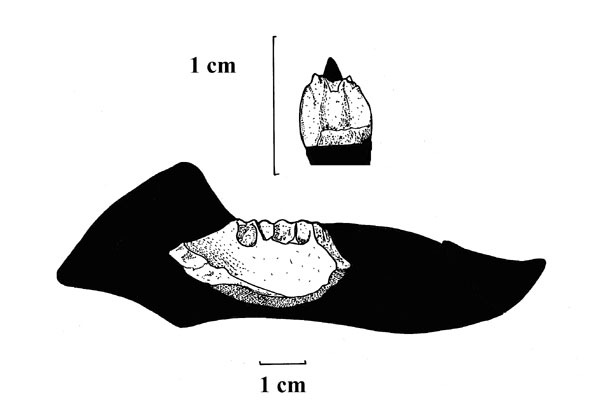
_____________________________________________________________________________________
Species: sinensis YOUNG, 1958
Etymology: Latin, sinensis, "China."
= Psittacocaurus sinensis CHENG, HU & FANG,
1995 (sic)
Holotype: IVPP V738
Locality: Hill slope N.W. of Toushan Village about 5 km N.W. of the Laiyang City, Shandong (Shantung) Province, China.
Horizon: Qingshan (Upper Chinshan Beds in the dark red clay) Formation.
Biostratigraphy:
Age: Aptian-Albian Stage, Middle Gallic Subepoch, Upper Early Cretaceous Epoch, Early Cretaceous.
Material: Skull, dentary and nearly complete skeleton.
Note: With a furcula.
Referred material:
IVPP V743: Maxilla with four teeth and some (8?) isolated teeth.
Note: Possibly represented by 2 individuals.IVPP V743a: Broken teeth and fragments of bones including proximal part of a femur.
IVPP V742: A broken skull with maxillae and teeth.
IVPP V740-741: Part of skeleton with vertebrae and many broken ones with a complete femur, mostly belong to one individual.
IVPP V739: Sacrum, ilia, posterior dorsal vertebrae and ribs and anterior caudal vertebrae all complete. Part of ischium, femora, tibia and fibula.
IVPP V745: Maxilla with 4 teeth and an isolated tooth.
Locality: A small hill N.E. of the Laiyang City, from the Village of Hsiliuhang, eastern side of Pelungho, Shandong (Shantung) Province, China.Horizon:
Biostratigraphy:
Age: Early Cretaceous.
Material:
IVPP V754: Anterior part of a broken skull, disarticulated upper and lower jaws and a few vertebrae.
IVPP V752: Maxilla with 5 teeth, 2 distal parts of femora, 1 sacral vertebrae, broken sacral vertebra, broken sacrum.
IVPP V750: Part of consecutive ribs preserved in a piece of rock representing the dorsal part of an individual.
IVPP V753: An internal mold of a skull and some fragments of bones.
IVPP V744: A nearly complete skull, the posterior part being broken, vertebrae and limb bones, mostly broken.
IVPP V749: Partly complete skeleton, while the badly disordered skeleton are much broken, only the anterior part is tolerably preserved.
= Psittacosaurus youngi CHAO, 1963
Etymology: In honor of C. C. Young.Holotype: BNHM PPV.149
Locality: 5 km north of Tosan, Ching San stratification in Pan Ion Wan, Laiyang, Shandong (Shantung) Province, China.
Horizon: Qingshan (Upper Chinshan Beds in the dark red clay) Formation.
Biostratigraphy:
Age: Aptian-Albian Stage, Middle Gallic Subepoch, Upper Early Cretaceous Epoch, Early Cretaceous.
Material: Skull and fragmentary skeleton.
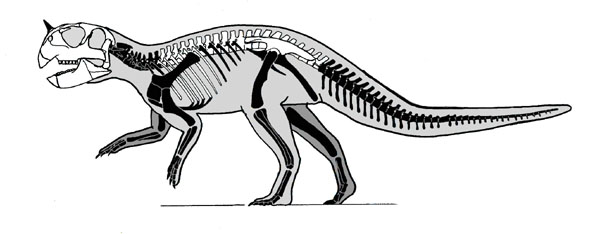
_____________________________________________________________________________________
Species: xinjiangensis SERENO, & CHAO, 1988
Etymology: Specific name refers to the geographic region that includes the
type locality.
Holotype: IVPP V7698
Locality: Delunshan, Junggar Basin, Xinjiang Uygur Zizhiqu (Sinkang) Province, Northern China.
Horizon: Lianmugin Formation, Tugulu Group.
Biostratigraphy:
Age: Aptian-Albian Stage, Middle Gallic Subepoch, Upper Early Cretaceous Epoch, Early Cretaceous.
Material: Articulated sub adult skeleton including the crushed posterior portion of the skull, but lacking both carpi, the right and most of the left manus, both hind limbs beyond the proximal ends of the tibiae, and most of the tail.
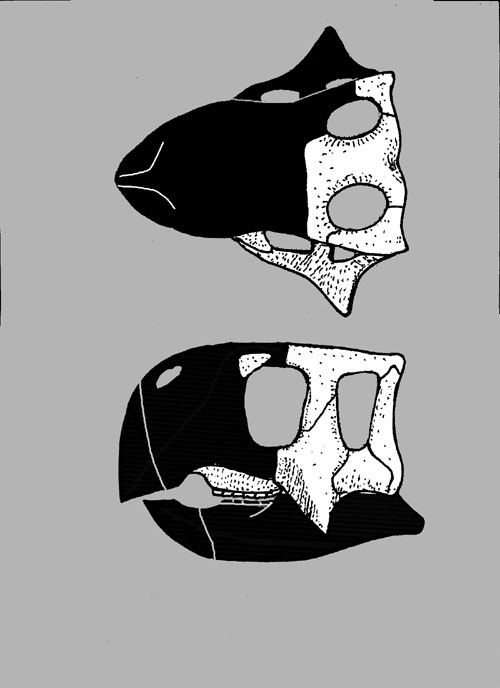
Referred material:
IVPP V7701: Fragmentary right ilium, left pubis, and distal right and left fibulae of possible association, a second individual represented by a pair of fragmentary fibulae, and vertebrae from several individuals.
IVPP V7702: Right and left maxillary fragments each with 5 teeth and an anterior right dentary fragment.
IVPP V7703: Left maxillary fragment with unworn replacing crown and an anterior right dentary fragment.
IVPP V7704: Complete right maxilla with 8 alveoli and left dentary fragment with single, erupting dentary crown.
IVPP f.n. 64047-6: Fragmentary postcrania of several individuals.
IVPP f.n. 64047: Skeletal fragments of several individuals including 2 maxillae with teeth, 9 jugal horns, an articulated basioccipital, basisphenoid, and ventral exoccipital fragment, dorsal and caudal vertebrae, 9 proximal scapulae, 6 dorsal scapulae, 5 coracoids, 12 distal humeri, 2 distal ulnae, 1 distal radius with articulated radiale, 9 proximal femora, 5 distal tibiae (2 with articulated astragali and 2 with articulated astragali and calcanea, a right astagralus and 2 right calcanea).
BRINKMAN, EBERTH, RYAN & CHEN, 2001
Locality: 10 km east-southeast of Urho, Western Junggar Basin, Xinjiang Uygur Zizhiqu (Sinkang) Province, China.
Horizon: Tugulu Group.
Biostratigraphy:
Age: Early Cretaceous.
Material:
UGM XG94Kh201: A partial skeleton, including skull and jaw fragments, atlas, centrum, much of the presacral vertebral column and complete sacrum, partial right forelimb, and complete right hind limb.
_____________________________________________________________________________________
Species: meileyingensis SERENO, CHAO, CHENG & RAO, 1988
Etymology: Meileyingzi, Liaoning
Province, northeastern China in reference to the geographic region that includes the
type locality.
= Psittacosaurus chaoyoungi WANG, ZHENG, ZHANG, PU,
ZHANG, WU, JU, DONG,& YUAN, 1989 (nomen nudum)
Holotype: IVPP V7705
Locality: Meileyingzi, approximately 60 km southwest of Chaoyoung City, Liaoning Province, northeastern China.
Horizon: Horizon IV, Jiufotang Formation, Upper Jehol Group.
Biostratigraphy: Pistacosaurus fauna, Cathayornis-Chaoyanga Avifauna.
Age: Barremian Stage, Lower Gallic Subepoch, Lower Early Cretaceous Epoch, Early Cretaceous.
Material: Nearly complete skull with articulated lower jaws and anterior 3 cervical vertebrae.
Referred material:
BNHM BPV.399, BPV.401: 2 fragmentary adult skulls.
BNHM BPV.400: Weathered juvinel skull.
BNHM BPV.401: Very fragmentary, disarticulated, adult skull.
IG V.300: Adult skull lacking the anterior snout, posterio-lateral corner of the skull roof, posterior right jugal and left maxilla, right and left mandibular rami disarticulated, lacking the symphyseal region and predentary, 2 sacral centra, 8 articulated caudal vertebrae with chevrons, proximal left scapula, left coracoid, right ilium lacking the ischiac peduncle and postacetabular process, proximal left ischium, proximal left femur, left distal tibia, left proximal and distal tarsals, and left metatarsals 1-4.
_____________________________________________________________________________________
Species: sattayaraki BUFFETAUT & SUTEETHORN,
1992
Etymology: In honor of Nares Sattayarak, who discovered the type specimen.
Holotype: TF 2499
Locality: 20 km east of the city of Chaiyaphum, Khorat Plateau Ban Don Bang Noi, Chaiyaphum Province, north-eastern part of Thailand.
Horizon: Khok Kruat Formation.
Biostratigraphy:
Age: Aptian-Albian Stage, Middle Gallic Subepoch, Upper Early Cretaceous Epoch, Early Cretaceous.
Material: Fragmentary right dentary.
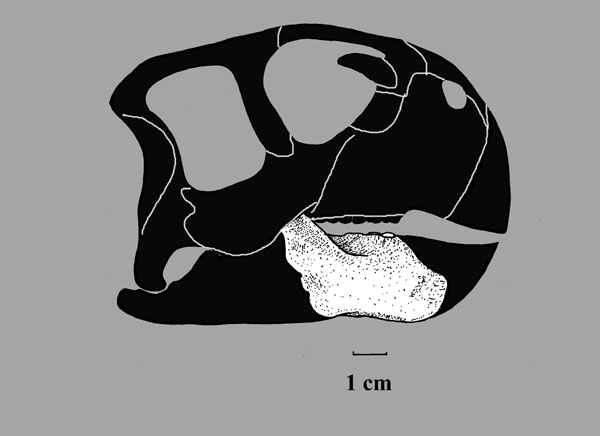
Referred material:
TV 2499b: Maxilla fragment.
BUFFATUT, 2007
Number: Not given:
Locality: Laos.
Horizon: Equivalent to the Khok Kruat Formation.
Biostratigraphy:
Age: Aptian-Albian Stage, Middle Gallic Subepoch, Upper Early Cretaceous Epoch, Early Cretaceous.
Material:
Numbers: Not given:
_____________________________________________________________________________________
Species: neimongoliensis RUSSELL & ZHAO, 1996
Etymology: Refers to the Inner Mongolia Autonomous Region (Nei Mongol Zizhiqu)
in which the type locality occurs.
Holotype: IVPP 12-0888-2
Locality: 1 km southeast of Yangpo village, 10 km north of main east-west highway, 80 km west of Dongsheng, and 63 km east of Hangginqi, in Ordos region, Ordos (Shaan-Gan-Ning) Basin, Inner Mongolia (Nei Mongolia), China.
Horizon: Ejinhoro Formation.
Biostratigraphy:
Age: Early Cretaceous.
Material: Nearly complete skeleton lacking much of braincase and distal caudal vertebrae.
Note: Paleopathology, infection-induced exostoses on the left transverse porcess of the 7th dorsal in front of the sacrum. The proximal end of the associated rib is also pathologically swollen and dorsoventrally pierced by a large oval foramen.
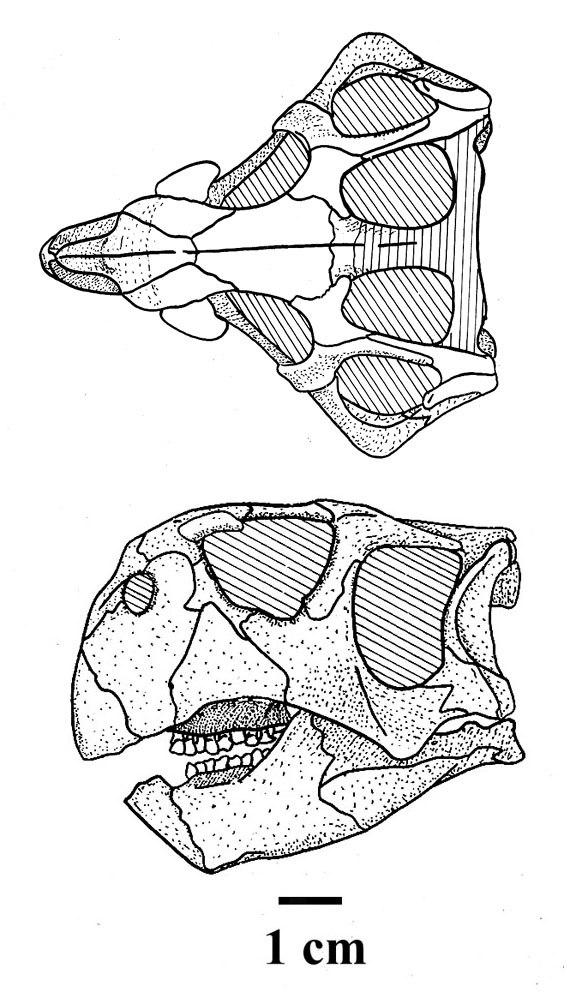
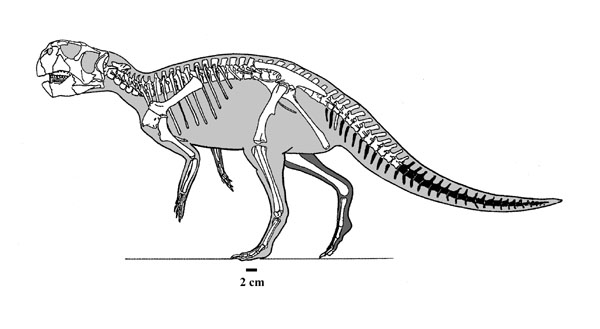
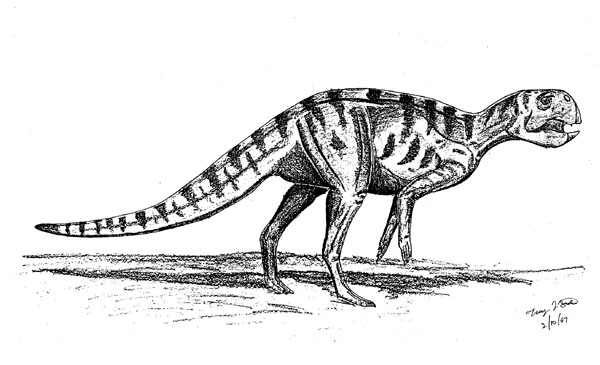
Referred material:
IVPP 07-0888-11: Partially disarticulated skull.
IVPP 12-0888-1: Centra from 1 dorsal, 6 sacral, and 17 associated caudal vertebrae, fragments of ilia, right ischium, most of right and parts of left hind limb.
IVPP 12-0888-3: Right lateral margin of skull and mandible, and anterior portions of skeleton.
3 unprepared specimens.
_____________________________________________________________________________________
Species: ordosensis RUSSELL & ZHAO, 1996
Etymology: Refers to the Ordos region of Inner Mongolia.
= New species RUSSELL & DONG, 1993
Holotype: IVPP 07-0888-1
Locality: Exposures of cross-bedded red sandstone 0.7 km west of Muhuaxiao Village (39’36”N, 108’41”E). Near the villages of Huamuxiao and Amulonggui. Near the latter village, 1 km to the south of the former, Huamuxio village is 4.1 km west of the town of Duguijiahan, Ordos (Shaan-Gan-Ning) Basin, Inner Mongolia (Nei Mongolia), China.
Horizon: Ejinhoro Formation.
Biostratigraphy:
Age: Early Cretaceous.
Material: Nearly complete skeleton lacking much of braincase and distal caudal vertebrae.
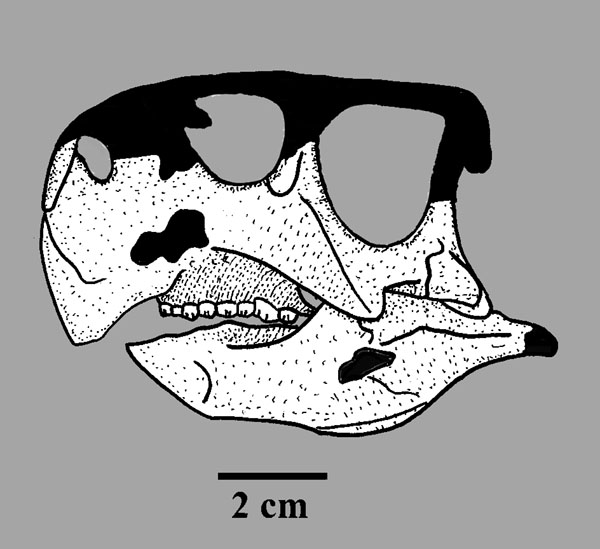
Referred material:
IVPP 07-0888-5: Left jugal and quadrate, 2 cervical vertebrae, several vertebral and rib fragments, and left scapula.
5 unprepared specimens.
_____________________________________________________________________________________
Species: mazongshanensis XU, 1997
Etymology: In reference to the town of Mazongshan, Gansu (Kansu) Province,
China.
Holotype: IVPP V 12165
Locality: Gongpoquan Basin, Town of Mazongshan, Subei Mongol Autonomous, Jiuquan City, Gansu (Kansu) Province, China.
Horizon: Middle grey unit of Zhonggou Formation, Xinminbao Group.
Biostratigraphy:
Age: Albian Stage, Middle Gallic Subepoch, Upper Early Cretaceous Epoch, Early Cretaceous.
Material: Fragmentary skull, associated cervical, dorsal and sacral vertebrae,
and a forelimb, with gastroliths.
_____________________________________________________________________________________
Species: liangi LIU, 1999 (nomen nudum)
Etymology:
Holotype:
Locality: Liaoning Province, China.
Horizon:
Biostratigraphy:
Age: Late Jurassic/Early Cretaceous.
Material:
_____________________________________________________________________________________
Species: sibiricus VORONKEVICH & AVERIANOV, 2000
Etymology: In reference to Siberia, where the specimen was discovered.
= Psittacosaurus mongoliensis NOVIKOV, LEBEDEV & ALIFANOV, 1998,
MASCHENKO & LOPATIN, 1998, ROZHDESTVENSKY, 1960
= Psittacosaurus xinjiangensis NESOV, 1995, NOVIKOV, LEBEDEV & ALIFANOV,
1998
Holotype: PM TGU 16/4-20
Locality: Sh-3 (Shestakovo 3), approximately 40 km south of Mariinsk City, 55°54’12”N latitude and 87°57’28”E longitude, Chebula District, Kemerovo Province, Western Siberia, Asian Russia.
Horizon: Ilek Formation.
Biostratigraphy:
Age: Khukhtekian age, Aptian-Albian Stage, Middle Gallic Subepoch, Upper Early Cretaceous Epoch, Early Cretaceous.
Material: Skull and nearly complete skeleton.
Referred material:
AVERIANOV, VORONKEVICH, LESHCHINSKIY & FAYNGERTZ, 2006
PM TGU 16/0-2: Fragmentary left ilium.
PM TGU 16/0-3: Fragmentry right ilium and 0-1: Left ischium from a single large individual described by Voronkevich (1998).
PM TGU 16/0-7, -277: Right radius.
PM TGU 16/0-10, -1-58: Right postorbitals.
PM TGU 16/0-12, -13: Left jugal horns.
PM TGU 16/0-14, -75: Fragmentary sapular blades.
PM TGU 16/0-14, 1-13, 1-48, 1-211: Right palebrals.
PM TGU 16/0-15: Fused basioccipital and basisphenoid and PM TGU 16/0-18: Left ectopterygoid from a single individual.
PM TGU 16/0-16: Fragmentary right pterygoid.
PM TGU 16/0-17: Fragmentry left pterygoid articulated with th equadrate pterygoid ramus.
PM TGU 16/0-19: Left quadrate condyle.
PM TGU 16/0-20, 1-175, 1-203: Right dentaries.
PM TGU 16/0-21: Basioccipital.
PM TGU 16/0-22: Atlas interentrum.
PM TGU 16/0-23: Axis and 0-24-27: Cervicles 3-6 from a single individual.
PM TGU 16/0-28, -29: Articulated posteior dorsals.
PM TGU 16/0-30-39: Articulated series from the first sacral (fragmentary towards fourth caudal.
PM TGU 16/0-41: Left ulna and -42, left radius of a single individual.
PM TGU 16/0-43, -51: Left metatarsal IV proximal ends.
PM TGU 16/0-44: Right metatarsal IV proximal end.
PM TGU 16/0-45: Right metatrsal IV distal end.
PM TGU 16/0-46: Right metatarsal II.
PM TGU 16/0-47, -57: Right metatarals I.
PM TGU 16/0-49, -50, 1-5, -146: Left metatarsals III.
PM TGU 16/0-49: Right metatarsal I distal end.
PM TGU 16/0-52: Left metatarsal I distal end.
PM TGU 16/0-54: Right femur distal end.
PM TGU 16/0-55, -66: Right femur proximal ends.
PM TGU 16/0-56: Left femur distal end.
PM TGU 16/0-62, -65, 1-271: Left femora.
PM TGU 16/0-63, -72: Right tibia distal ends.
PM TGU 16/0-64: Left humerus.
PM TGU 16/0-67, -73: Left tibia distal ends.
PM TGU 16/0-68: Articulated right tibia and fibula distal ends of right astraglus.
PM TGU 16/0-69, -70: Left tibia proximal ends.
PM TGU 16/0-71: Right humerus distal end.
PM TGU 16/0-76: Left humerus distal end.
PM TGU 16/0-78: Right calcaneum.
PM TGU 16/0-79: Fragmentary right ischium.
PM TGU 16/1-11, -220, -233, -255: Chevrons.
PM TGU 16/1-17: Left palpebral.
PM TGU 16/1-18, -20, -21, -223, -227, -264, -268, -169, -170, -182, -248, -249, -250, -251, -252, -253: Caudal centra.
PM TGU 16/1-19, -22, -25, -27, -33, -36, -41, -109, -111, -138, -243, -260, -278: Dorsal ribs (double headed).
PM TGU 16/1-22, -26, -43, -89, -151, -227, -289: Cervical ribs.
PM TGU 16/1-23, -60: Dorsal ribs (single headed).
PM TGU 16/1-29, -102, -103, -105, -152, -259: Caudal neural arches.
PM TGU 16/1-29, -30, -31, -50, -77, -95, -143, -145, -210, -213, -214, -217, -235, 0254, -255: Caudals.
PM TGU 16/1-34, -256: Right pubis.
PM TGU 16/1-37: Left metatarsal IV.
PM TGU 16/1-40: Right metatarsal IV.
PM TGU 16/1-42 and 1-153: Axis neural arches.
PM TGU 16/1-44: Left palatine fragment.
PM TGU 16/1-45, -72, -74, -76, -94, -215, -231, -234: Neural arches of posterior dorsals.
PM TGU 16/1-46: Fragmentary right premaxilla and 16/1-73: Right maxilla from a single individual.
PM TGU 16/1-47, -52, 0-40: Right ulnae
PM TGU 16/1-49, -63, -154: Sacral ribs.
PM TGU 16/1-51: Sternal plate.
PM TGU 16/1-56, -85, -174: Left dentaries.
PM TGU 16/0-61: Left astagalus.
PM TGU 16/0-77, 1-275: Left calcanei.
PM TGU 16/1-79: Left ectopterygoid.
PM TGU 16/1-82: Juvenile right humerus distal end.
PM TGU 16/1-83, -115, -126: Juvenile left tibia distal ends.
PM TGU 16/1-84: Juvenile right humerus.
PM TGU 16/1-92, 1-107: Left pterygoids.
PM TGU 16/1-104, -288: Fragmentary right exoccipital/opisthotic.
PM TGU 16/1-106: Right scapula proximal fragment.
PM TGU 16/1-116: Juvenileleft metatarsal.
PM TGU 16/1-129: Fragmentary right scapula.
PM TGU 16/1-133: Juvenile right premaxilla.
PM TGU 16/1-135: Fragmentary left quadrates of a juvenile.
PM TGU 16/1-136: Left exoccipital/opisthotic.
PM TGU 16/1-137: Fragmentary right angular.
PM TGU 16/1-158, -276: Right coracoids.
PM TGU 16/1-163, -178, -183: Anterior dorsals.
PM TGU 16/1-166, -285: Left postorbitals.
PM TGU 16/1-167: Right ilium.
PM TGU 16/1-171: Fragmentary astagalus.
PM TGU 16/1-173: Right pterygoid.
PM TGU 16/1-176, -246: Fragmentary left angulars.
PM TGU 16/1-177, 3-30-34: Isolated teeth.
PM TGU 16/1-179: Articulated left tibia an dastragalus.
PM TGU 16/1-181: Juvenile left femur.
PM TGU 16/1-200: Articulated left pes.
PM TGU 16/1-201: Almost complete left manus lacking.
PM TGU 16/1-202: Left quadrate.
PM TGU 16/1-204: Right prmaxilla and 16/1-206: Right maxilla from a single individual.
PM TGU 16/1-207: Left premaxilla.
PM TGU 16/1-208: 3 associated caudals.
PM TGU 16/1-209, -232, -233: Cervicals.
PM TGU 16/1-212: 2 associated caudals.
PM TGU 16/1-216: Fragmentary rostral.
PM TGU 16/1-228: Left humerus.
PM TGU 16/1-230: Atlas intercentrum.
PM TGU 16/1-245: Fragmentary left nasal.
PM TGU 16/1-247: Right humerus.
PM TGU 16/1-257: Left pubis.
PM TGU 16/1-258: Right quadrate.
PM TGU 16/1-261: Right metatarsal III lacking proximal end.
PM TGU 16/1-264: Right exoccipital/opisthotic.
PM TGU 16/1-270: Left ischium.
PM TGU 16/1-272, -273, -274: Associated left tibia, astragalus and fibula.
PM TGU 16/1-279: Incomplete right manus.
PM TGU 16/1-281, -295, -127: Left clavicles.
PM TGU 16/1-282: Fragmentary right clavicle.
PM TGU 16/1-283: Fused parietals.
PM TGU 16/1-284: Left maxilla.
PM TGU 16/1-286, -287: Fragmentary left exoccipital/opisthotic.
PM TGU 16/1-187: Left fibula lacking distal ends.
PM TGU 16/1-290: Right humerus proximal end.
PM TGU 16/1-292: Fragmentary right dentary.
PM TGU 16/1-292, -293: Fragmentry juvenile left and right jugals.
PM TGU 16/1-294: Right nasal.
PM TGU 16/1-296: Right clavicle.
PM TGU 16/1-297: Right palatine fragment.
PM TGU 16/4-21: Nearly complete articulated adult skeleton with skull, burried together with holotype, possibly female.
Numbers: Not given: Numerous less important isolated vertebrae, ribs, chevrons, teeth, phalanges metapodials and bone fragments.
_____________________________________________________________________________________
Species: lujiatunensis ZHOU, GAO, FOX, & CHEN, 2006
Etymology:
In reference to the type locality, Lujiatun, near Beipiao, Liaoning Province, China.
Holotype: ZMNH M8137
Locality: Lujiatun, near Beipiao, Liaoning Province, China.
Horizon: Lowest part of the Yixian Formation.
Biostratigraphy:
Age: Hauterivian Stage, Late Neocamian Subepoch, Middle Early Cretaceous Epoch, Middle Early Cretaceous.
Material: A nearly complete skull with lower jaws.
Paratypes:
ZMNH M8138: A nearly complete, but somewhat compressed skull with lower jaws and the anteriormost 3 cervical vertebrae.
PKUP V1053: A complete and slightly compressed skull and fragments of lower jaws of a juvenile.
PKUP V1054: A complete and slightly compressed skull with lower jaws, poratlas and atlas of a young adult individual.
ZHOU, GAO, FOX & DU, 2007
PKUP V1060: Large skull.
Referred material:
BULLAR, ZHAO, BENTON & RYAN, 2019
IVPP V15451: Hatchling skull.
IVPP V22647: Skull of a 2 year old specimen.
ERICKSON, MAKOVICKY, INOUYE, ZHOU & GAO, 2009, ZHOU, GAO & FOX, 2010
IVPP uncatalogued, 12074, 14155, V12617, V12704, D2156, PKUVP V1055 (with ossified tendons), V1056 (with ossified tendons), V1058, V1057, LPM R00117, R00119, R00121, R00122, R00124, R00126, R00128, R00132, R00133, R00135, R00136, R00137, R00138,R00140, R00141, R00142, R00143, JZMP V11, LHPV 1: Fragmentary specimens.
HEDRICK, GAO, TUMARKIN-DERATZIAN, SHEN, HOLLOWAY, ZHANG, HARKENSON, LIU, ANNE, & DODSON, 2016
DMNH D2596: Fragmentary skeleton, with a pathologic left tibia.
ZHAO, BENTON, XU & SANDER, 2014
IVPP V14341: A cluster of six juveniles.
= Psittacosaurus major SERENO, ZHAO, BROWN & TAN, 2007
Etymology: Latin, major, "meaning greater."Holotype: LH PV1
Locality: Lujiatun site, Shangyuan, Beipiao, Liaoning Province, China.
Horizon: Lower Yixian Formation.
Biostratigraphy:
Age: Valanginian Stage,- Berriasian Stage, Lower Neocomian Subepoch, Lower Early Cretaceous Epoch, Early Cretaceous.
Material: Articulated skull and nearly complete postcranial skeleton. The skull is nearly complete lacking only the right, and most of the left, palpebral, and portions of the right postorbitaland squamosal: The skeleton is missing the left pubis, right radius and portions of right manus, left tibia and fibula, and portiosn of the left pes.
Referred material:
HAN, MALLON, LUSSIER, WU, MITCHELL & LI, 2023
Locality: West of Lujiatun Village, N41°36'24", E120°54'40, Liaoning Province, China.
Horizon: Lujiatun Member, Yixian Formation.
Biostratigraphy:
Age: Valangian Stage,- Berriasian Stage, Lower Neocomian Subepoch, Lower Early Cretaceous Epoch, Early Cretaceous.
Material:
WZSSM VF000011: Complete skull and skeleton. Note: with a complete skeleton of Repenomamus robustus with both in combat.
YOU, TANOUE & DODSON, 2008
Locality: Lujiatun, near Beipiao, Liaoning Province, China.
Horizon: Lujiatun beds, Lowest part of the Yixian Formation.
Biostratigraphy:
Age: Hauterivian Stage, Late Neocamian Subepoch, Middle Early Cretaceous Epoch, Middle Early Cretaceous.
Material:
CAGS-IG-VD-004: Fragmentary skull and dentary.
= Hongshanosaurus houi YOU, XU & WANG, 2003
Etymology: In honor of Prof. Hou Lianhai, who allowed the authors to study ths specimen.
= Psittacosaurus houi (YOU, XU, & WANG, 2003) SERENO, 2010Holotype: IVPP V12704
Locality: Lujiatun site, Shangyuan, Beipiao, Liaoning Province, China.
Horizon: Horizon 1, Lower part of the Yixian Formation, Jehol Group.
Biostratigraphy: Psittacosaurus Fauna, Confuciusornis Avifauna.
Age: Valanginian Stage, Upper Neocomian Subepoch, Early Early Cretaceous Epoch, Early Cretaceous.
Material: Skull missing snout tip.
Referred material:
YOU & XU, 2005
IVPP 12617: A complete adult skull and lower jaw.
_____________________________________________________________________________________
Species: gobiensis SERENO, ZHAO & TAN, 2010 (published in 2009)
Etymology: Gobi, after the Gobi Desert and Latin, -iensis, belonging to.
Holotype: LH PV2
Locality: Suhongtu, 40°59'42.4"N, 104°3'53.8"E, nei Mongol autonomous Region, Inner Mongolia, China.
Horizon: Bayan Gobi Formation.
Biostratigraphy:
Age: Aptian Stage, Middle Gallic Subepoch, Upper Early Cretaceous Epoch, Early Cretaceous.
Material: Skull and articulated postcranial skeleton.
Note: Has gastroliths.
_____________________________________________________________________________________
Species: amitabha NAPOLI, HUNT, ERICKSON & NORELL, 2019
Etymology: The celestial Amitabha Buddha in the Buddha of infinite light, and one of his attributes is extreme longevity. Amitabha is the principal Buddha of Pure Land Buddhism and is highly venerated in Mongolia.
Holotype: IGM 100/1132
Locality: Ondai Sayr locality, Mount Ussuk, Tsagan Nor Basin, Hovd Province, Mongolia.
Horizon: Andakhuduk Formation (old Ondai Sair Formation).
Biostratigraphy:
Age: Barremian Stage, lower Gallic Subepoch, lower Early Cretaceous Epoch, Early Cretaceous. (was thought to be Aptian-Albian Stage, Middle Gallic Subepoch, Upper Early Cretaceous Epoch, Early Cretaceous).
Material: A nearly complete undistored skull with an associated partial mandible and fragmentary postcranial elements.